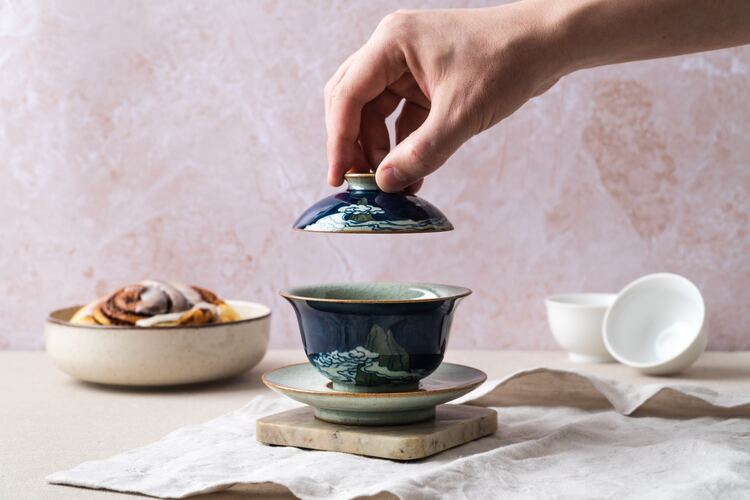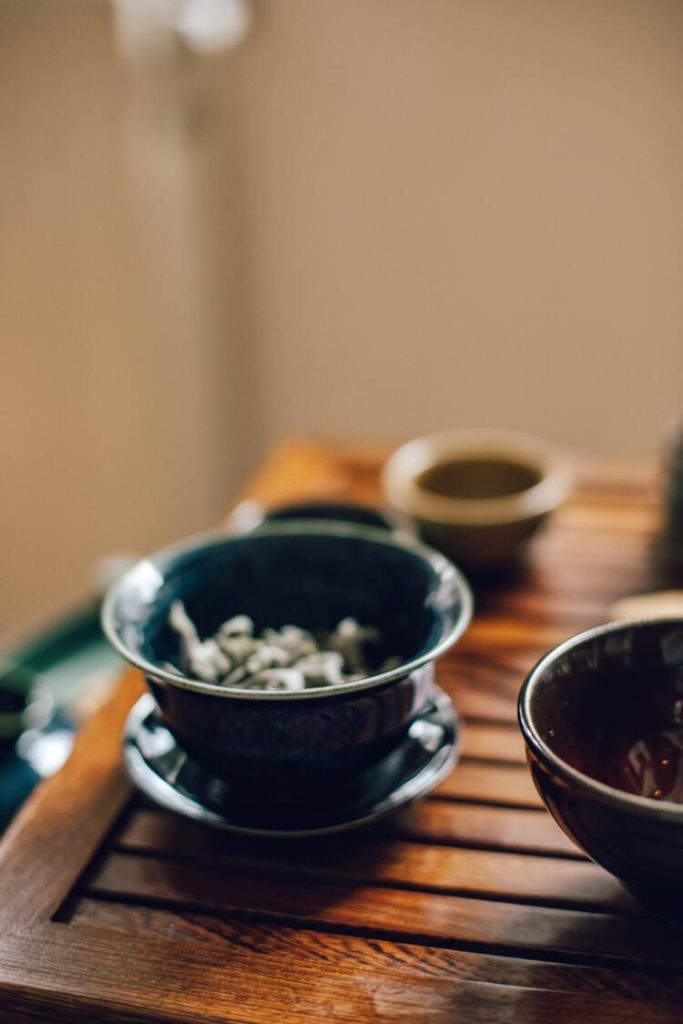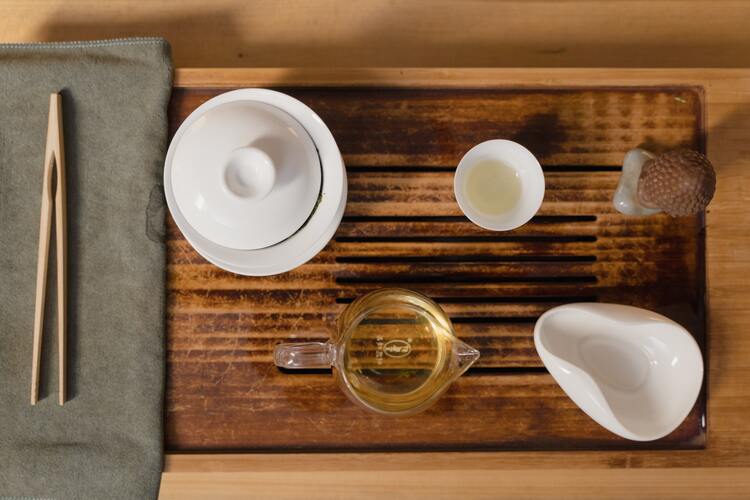Tie Guan Yin tea, also known as Iron Goddess, is popular among tea drinkers. This oolong tea is known for its floral and fruity notes, with a slight hint of smokiness.
Tie Guan Yin originated in China’s Fujian province and is one of the most famous teas in China.
This article discusses everything you need to know about this highly regarded tea, including its legend, processing method, varieties, and health benefits.
Please note: This article contains affiliate links, meaning I may earn a commission if you make a purchase by clicking a link. Of course, this comes at no extra cost to you and helps me keep offering readers solid information.

Legend of Tie Guan Yin Tea
Tie Guan Yin is an oolong tea with a rich history dating back to the Qing Dynasty in China.
Legend has it that during the Qing Dynasty in China, there was a rundown temple with an iron statue of the Buddhist deity Guan Yin. The locals would visit the temple to pay their respects and maintain the statue.
In the 18th century, a poor farmer from Fujian Province named Wei Yin discovered the temple and decided to contribute his efforts to its maintenance. He regularly swept the temple, lit incense, and cleaned the statue. As a token of appreciation, the goddess appeared and gave Wei Yin a tea plant cutting, which was said to be descended from a wild tea tree near the temple.
Wei Yin carefully nurtured the tea plant and eventually harvested its leaves. He found that the tea produced from this plant had a different flavor and aroma. He shared his discovery with others in his village, and the tea gained popularity for its exceptional qualities. In honor of the temple’s deity, the tea was named Tie Guan Yin, which means “Iron Goddess of Mercy.”
Over time, Tie Guan Yin tea gained recognition and spread beyond the local village.
Note: There are many versions of this legend. You may encounter different details in other sources.
Tie Guan Yin Tea Processing
Regarding Tie Guan Yin tea, the processing method differentiates this tea from other oolong teas. The process is complex and requires craftsmanship with the appropriate flavor profile.
Within Fujian, specific regions are known for producing high-quality Tie Guan Yin tea. Anxi County is one of the most famous and traditional areas for its cultivation and processing. Anxi Tie Guan Yin is highly regarded for its distinctive flavor and aroma.
The following steps outline the typical process:
- Harvesting: Skilled tea pickers selectively pluck the tea leaves, usually in the spring or autumn when the leaves are at their peak quality. The leaves are carefully chosen, often selecting the young and tender ones.
- Sun Withering: The freshly picked tea leaves are spread thinly outdoors to wither. This step allows excess moisture to evaporate and reduces the leaf’s moisture content, making them more pliable for subsequent processing.
- Cooling: After withering, the leaves undergo a brief cooling period to halt further enzymatic reactions and preserve their freshness.
- Tossing: Tossing is one of the crucial steps in the process (and pretty unique to oolong teas). For this particular tea, the leaves are tossed several times. The objective is to achieve even oxidation and develop floral notes.
- Oxidation: The rolled tea leaves are left to oxidize in a temperature and humidity-controlled environment. The duration of oxidation depends on the desired style of tea. This stage contributes to the development of flavor and aroma.
- Fixation: To stop the oxidation process, the leaves are heated. This step helps preserve the tea’s color, flavor, and aroma while preventing further enzymatic activity.
- Rolling: The leaves are hand-rolled or mechanically rolled to shape them into balls.
- Roasting: Roasting can be done in multiple sessions, and it is a critical step in determining the final flavor profile of the Tie Guan Yin tea. The roasting may be done over charcoal, electric ovens, or other heat sources.
- Cooling and Sorting: After roasting, the tea leaves are cooled down to room temperature. They are then sorted to remove any damaged leaves, stems, or impurities, ensuring a consistent and high-quality product.
- Packaging: The final step involves packaging the Tie Guan Yin tea, often in sealed bags or containers, to protect it from moisture, light, and air, which can affect its freshness and flavor.
Flavor Profile
Tie Guan Yin is known for its complex and nuanced flavor profile, a key reason for its popularity among tea enthusiasts. The taste of this tea can vary depending on factors such as the specific cultivar, growing conditions, and processing techniques, but here are some general characteristics you can expect in its flavor profile:
- Floral: The tea often has a pronounced floral aroma and taste, with notes of orchid, lilac, and sometimes gardenia. This floral aspect contributes to its elegance and delicacy.
- Creamy or buttery: Some Tie Guan Yin teas exhibit a creamy, buttery texture, adding a smooth and rich quality to the tea. This characteristic is more prevalent in lightly oxidized Tie Guan Yin.
- Sweetness: Many Tie Guan Yin teas have a natural sweetness reminiscent of honey or ripe fruit, such as apricots or peaches. This sweetness balances the floral and vegetal notes.
- Vegetal: You may also detect vegetal undertones in Tie Guan Yin, resembling fresh greens or spinach. This aspect adds a refreshing and slightly savory dimension to the tea.
- Mineral or rocky notes: The tea may sometimes have mineral or stony undertones, which can provide depth and complexity to the flavor profile.
- Long-lasting aftertaste: A notable feature of this type of oolong is it’s lingering aftertaste, often described as “huigan.” This aftertaste can be sweet, floral, or mineral.

Types of Tie Guan Yin Tea
There are several types and varieties of Tie Guan Yin. This is because of variations in the processing or growing regions. Here are some of the types you can try:
- Traditional: This is the most classic and widely recognized style of Tie Guan Yin. It is typically medium to high roasted, resulting in a rich, deep flavor with notes of roasted nuts, caramel, and a smooth, lingering aftertaste.
- Light Roast: This style is lightly roasted, preserving the tea’s delicate floral and orchid-like fragrance. It offers a lighter and more refreshing taste with subtle hints of fruitiness and a clean finish.
- Charcoal Roast: This type of Tie Guan Yin undergoes a more intense roasting process using charcoal, which imparts a smoky and robust flavor. It often exhibits a deeper reddish-brown color and a distinctive charcoal aroma.
- Aged: Some Tie Guan Yin teas are intentionally aged, allowing them to develop unique flavors and complexities over time. These teas may be stored for several years or decades, resulting in deeper flavors, mellowed astringency, and sometimes a hint of medicinal notes.
- Green: This style of Tie Guan Yin is minimally oxidized and lightly roasted, preserving the tea’s green color and fresh, grassy taste. It offers a vibrant and crisp profile with floral undertones.
- Competition Grade: For tea competitions and connoisseurs, there are special grades of Tie Guan Yin produced, known as competition grade or premium grade. These teas are meticulously crafted from carefully selected leaves and exhibit exceptional quality, complexity, and balance. They are often characterized by a harmonious combination of floral, fruity, and toasty flavors.
- Taiwan: This type of Tie Guan Yin tea is grown in Taiwan and is known for its creamy texture and sweet, floral taste.
No matter which type of Tie Guan Yin tea you choose, you will surely be in for a treat!
Brewing Tie Guan Yin Tea
Gong Fu Brewing Method
If you want to enjoy the full flavor of Tie Guan Yin, then the Gong Fu brewing method is recommended. This method involves using a small teapot (Yixing clay teapot) and brewing the tea in multiple short infusions. This brewing method ensures the best taste. Here’s how you can do it:
- Preheat your teapot and cups by rinsing them with hot water.
- Add the tea leaves to the teapot. The amount of tea leaves will depend on the size of your teapot, but a general guideline is 1-2 teaspoons of leaves for every 6-8 ounces of water.
- Pour hot water over the tea leaves and immediately pour it out. This helps to rinse the tea leaves and awaken their flavor.
- Refill the teapot with hot water and steep it for about 20-30 seconds.
- Pour the tea into your cups and enjoy the fragrant aroma and delicate taste.
- Repeat steps 4 and 5 for multiple infusions, gradually increasing the steeping time with each infusion. You can increase each infusion’s steeping time by 10 to 20 seconds.
Please pay attention to the last step. You can (and should) infuse your oolong tea multiple times. Please make the most out of it!
Gaiwan Brewing Method
You can use a gaiwan to brew tea as well. A gaiwan is a traditional Chinese tea vessel that allows you to control your tea’s temperature and steeping time. Here’s how to use it:
- Warm the gaiwan and tea cups with hot water,
- Add the tea leaves to the gaiwan. Use 1-2 teaspoons of leaves for every 6-8 ounces of water.
- For heavily roasted oolongs, pour hot water over the tea leaves and immediately pour it out. This helps to rinse the tea leaves and awaken their flavor.
- Slowly pour water over the leaves till the rim of the gaiwan.
- Add the lid and steep for 20-30 seconds.
- Pour the tea into teacups. While doing this, hold the gaiwan with your thumb and middle finger. Secure the lid with the index finger.
- Repeat the process with multiple infusions.
Western Style Brewing
If you prefer to brew tea using Western methods, start by heating the water. Put one teaspoon of tea leaves into a tea infuser or strainer and place it in a cup. Pour the hot water over the leaves and let it steep for about 3-4 minutes. Remove the infuser or strainer, and enjoy your tea.
Ideal Water Temperature
The water temperature plays a crucial role in brewing this tea. If the water is too hot, it can burn the delicate tea leaves and ruin the flavor. On the other hand, if the water is too cold, it may not extract the full flavor of the tea leaves. Here’s the ideal water temperature for brewing this particular tea:
- Bring fresh, cold water to a boil.
- Let it cool down for 2-3 minutes until the water temperature reaches around 190-200°F (88-93°C).
- Pour the hot water over the tea leaves and let it steep for the desired time.
Remember to use fresh, cold water that is free of any impurities. Avoid tap water if possible, as it may contain chlorine or other chemicals that can affect the taste of your tea.

Health Benefits of Tie Guan Yin Tea
This type of oolong tea can provide various health benefits that can improve your overall well-being. Here are some of the benefits:
- Antioxidants: Rich in antioxidants that can help protect your body from free radicals, which can cause damage to your cells and lead to aging and diseases such as cancer and heart disease.
- Weight management: This can help you lose weight by boosting your metabolism and reducing your appetite. It can also help burn fat by increasing your energy levels.
- Heart health: Can improve your heart health by reducing cholesterol levels and lowering your risk of heart disease. It can also help regulate your blood pressure and improve your blood circulation.
- Bone density: It contains minerals such as calcium and magnesium that can help improve your bone density and prevent osteoporosis.
- Aging: Can help slow down the aging process by reducing oxidative stress and inflammation in your body.
- Appearance: Can improve the appearance of your skin by reducing acne, dark circles, and wrinkles. It can also promote hair growth and prevent hair loss.
- Amino acids: It contains amino acids such as theanine that can help reduce stress and anxiety and improve mood and cognitive function.
It is important to consume it in moderation and consult your doctor if you have any health concerns or are taking any medications that may interact with caffeine or other compounds in the tea.
Buying Tie Guan Yin Tea
You need to keep in mind some things when buying Tie Guan Yin.
Firstly, make sure to buy from a reputable vendor. Look for vendors with good reviews and ratings specializing in selling high-quality teas. You can also check for certifications such as organic or fair trade, indicating that the tea has been grown and processed sustainably and ethically.
Secondly, consider the grade of the tea. This type of oolong tea is typically graded based on the quality of the leaves, with higher grades indicating better quality. Grades can range from A to AAAA or even higher. Keep in mind that higher grades may come with a higher price tag but may also offer a more nuanced and complex flavor profile.
Thirdly, consider the form of the tea. The tea can come in loose-leaf form or tea bags. Loose-leaf tea typically offers a better flavor and aroma but requires more preparation time and equipment. Tea bags, conversely, are more convenient and easy to use but may not offer the same level of quality.
Here are some recommendations if you want to taste this tea:
Tie Guan Yin Oolong Tea – Iron Goddess of Mercy

Tie Guan Yin Tea with Tin Container

Anxi Tie Guan Yin Oolong Tea Loose Leaf

Frequently Asked Questions
What is the story behind the name ‘Iron Goddess of Mercy’ for Tie Guan Yin tea?
Tie Guan Yin is named after the Chinese goddess of mercy, Guanyin. According to legend, a poor farmer discovered a rundown temple dedicated to Guanyin and decided to clean it up. As a reward for his kindness, the goddess appeared to him in a dream and revealed a tea plant growing behind the temple. The farmer nurtured the plant, producing a unique and delicious tea named after the goddess who had blessed him.
What are the health benefits of drinking Tie Guan Yin tea?
Tie Guan Yin tea is packed with antioxidants, which can help to reduce the risk of chronic diseases such as cancer and heart disease. It also contains caffeine, which can help to boost your energy levels and improve your mental focus. Some studies have also suggested that Tie Guan Yin tea may help to lower cholesterol levels and promote weight loss.
What is the flavor profile of Tie Guan Yin tea?
Tie Guan Yin tea has a complex and layered flavor profile, with orchid, honey, and roasted nuts notes. It has a smooth and velvety texture and a long, lingering finish. The flavor can vary depending on the quality of the tea and the brewing method used.
How is Tie Guan Yin tea different from other oolong teas?
Tie Guan Yin tea is a type of oolong tea grown in China’s Fujian province. It is known for its unique flavor profile and ability to be steeped multiple times without losing flavor. Other oolong teas may have a different flavor profile and cannot withstand multiple steepings.
What is the best way to brew Tie Guan Yin tea?
To brew Tie Guan Yin tea, use water heated to around 195°F (90°C). Steep the tea for about 3-5 minutes, depending on your preference. You can use a gaiwan or a teapot to brew the tea, which can be steeped multiple times.
What is the history of Tie Guan Yin tea?
Tie Guan Yin tea has a long and fascinating history from the 18th century. It was first produced in the Fujian province of China and quickly became popular due to its unique flavor profile and health benefits. Today, it is enjoyed by tea lovers worldwide and is considered one of the finest oolong teas available.

I hope you enjoyed the article and learned something new. See you next time!
Have you tried this tea?